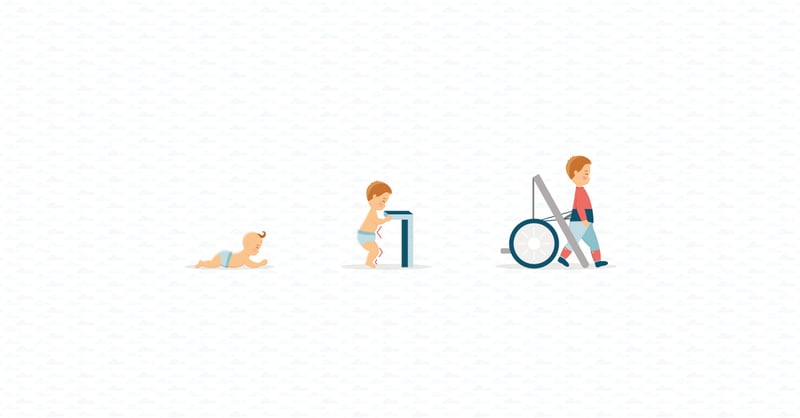10 Frequently Asked Questions about the gait trainer Hibbot


When you’re looking for the right assistive device for your child, you probably have lots of questions. It can be tough to navigate the sea of information that’s out there, so we’ve gathered the questions we get asked the most about the Hibbot. Below you’ll find the answers.
- Who will benefit from using the Hibbot as a gait trainer?
- What will my child gain from using the Hibbot?
- What is recommended age to start using the Hibbot?
- What is recommended height and weight of a child who can use the Hibbot?
- What are the main differences between the Hibbot and a conventional walker?
- What type of activities can I do to facilitate my child’s experience when using the Hibbot?
- Can my child fall over in the Hibbot?
- What is the uniqueness of the Hibbot?
- What level of service should I expect to maintain the product?
- How do I purchase the device? Is it possible for me to apply for funding or financial support?
1. Who can benefit from using the Hibbot?
Children who can benefit from using the Hibbot as a gait trainer are those who have potential to learn to walk either independently or by using a handheld walking aid. It can be children with cerebral palsy GMFCS levels II-III or other neurological disorders with mobility levels corresponding to the GMFCS levels II-III. A good indication to decide on whether the Hibbot is relevant for the child or not, is to test if the child can tolerate standing and/or walking with manual support of the pelvis. Other indications are no structural deformities, and that the child shows signs of motivation to stand and walk.
2. What will my child gain from using the Hibbot?
The Hibbot is an assistive device that provides high intensity gait training for children who have the potential to learn to walk independently or using a handheld walking aid. Unlike any other conventional walker, the Hibbot stabilizes pelvic and trunk instability with just enough support for the individual child. The device stimulates activity in gluteal extensor muscles and promotes postural alignment and balance, a prerequisite for optimal walking ability. The Hibbot simulates the physiotherapists’ hands-on gait training, bridging a gap between therapy intervention and daily stimulation of a child’s walking skills.
3. What is recommended age to start using the Hibbot?
The Hibbot is a dynamic walking aid that facilitates participation in everyday activities. It is recommended to start stimulating standing from as early as 11-13 months of age. At this age this is a common developmental phenomenon for most children to begin practicing standing.The Hibbot aims to replicate the physiotherapists’ hands on the pelvis and provide just enough support for the individual child to be able to stand up in a more functional and upright alignment. The device encourages activity in extensor muscles and promotes postural alignment and balance. This is a prerequisite to achieve optimal functional movement. When the child has gained enough strength to stand on their own with enough practice with extension over their hips, they then begin to learn how to walk in the device.
Read more: A physiotherapist’s experience the the new gait trainer, The Hibbot.
4. What is recommended height and weight of a child who can use the Hibbot?
The Hibbot can be used from as small as 60 cm in height and up to 125 cm. Maximum weight is 30 kg. The only parts that will require replacing in relation to the child’s growth are the brace and the wheels.
5. What are the main differences between the Hibbot and a conventional walker?
Four main differences:
- The Hibbot has a pelvic support (brace) replicating the hands of the therapist to be able to stand.
- There is no need for the child to hold on to the device with the hands like on a conventional walker, hence hands-free walking.
- The Hibbot challenges the child to move away from a flexed position and instead work on strengthening extensor muscles and finding balance.
- Small adjustments on the Hibbot makes it possible to adapt the amount of support needed to either give more support or to reduce the support due to progression of the child’s motor function.
6. What type of activities can I do to facilitate my child’s experience when using the Hibbot?
The intention with the Hibbot is to use it within daily activities either at home, in the kindergarten or outdoor. We encourage you to let the child perform its standing and walking training in functional and age-relevant activities. Examples: Cook the “lunch” in the play kitchen, or what about letting the child manage a shop? Children love these plays. Let the child walk with a trolley, indoor or outdoor. Let the child kick a ball in the hallway together with friends.
All these activities let the child focus on the activity and participation with peers and at the same time practice standing and walking training. This makes the training meaningful to the child. We have made a guideline for activities in the Hibbot for you.
7. Can my child fall over in the Hibbot?
The Hibbot consists of two fall protection “arms”. The fall-protection-support is adjusted to be just 5-10 cm above the floor. In case the child loses balance either forward or to the side, the fall-protection-support will hit the ground and protect the child from falling over.
In addition, the Hibbot has a compass that is turned ON or OFF to control lateral sway. With lateral sway the Hibbot will turn back into centre and the child will walk straight forward. The fall-protection-support and the compass enable the child to work safely on its balance in the Hibbot.
8. What is the uniqueness of the Hibbot?
Although the Hibbot seems straightforward from the look of it, it’s a comprehensive and smart device with state-of-the-art technology built into it. Human hands have always been a challenge to replicate in the robotics field, however, the Hibbot replicates all the hand movements a physiotherapist usually uses when supporting a child while walking. The Hibbot support is adjustable and smart enough to give the child just the support it needs to progress. This makes the Hibbot unique whilst remaining user-friendly.
Read more: How did the Hibbot come about?
9. What level of service should I expect to maintain the product?
Our highly skilled assistive device consultants coach individuals, advise and motivate users, caregivers and therapists.
During the first trial our consultant adapts the device to the child’s specific needs. We then teach and support the lead therapist prescribing the device how to make small, regular adjustments. This will ensure the device is correctly adjusted to facilitate growth and progression of the child’s motor function.
The Hibbot is a personal gait trainer and should only be used by the child it’s adapted for.
10. How do I purchase the device? Is it possible for me to apply for funding or financial support?
The system of reimbursement when purchasing assistive devices varies from country to country. We recommend that you to start by contacting your local Made for Movement office or distributor for more advice on how to proceed. If we are not represented in your country, you can contact the head office in Norway directly. You’ll find our contact details here.
If you have other questions related to the Hibbot please contact us for further information.
First published 10.01.2020.

Rikke Damkjær Moen brings many years of experience as clinical physiotherapist to the Made for Movement team. Her mission is to ensure that everybody, regardless of mobility problems, should be able to experience the joy and health benefits of physical activity. As our Medical Manager, Rikke is passionate about sharing knowledge so that individuals with special needs, families, and clinicians can discover the possibilities and solutions provided by Made for Movement.
A severe accident during a hockey game resulted in 35-year-old Tobias breaking his neck and becoming paralysed from the armpits down....
In this blog, we take you on a deep dive into universal design so you can understand and recognize how these principles are...
A disability entails the loss of, damage to, or deviation from bodily or psychological functions, in the form of mental, physical,...
Hear from us from time to time and learn new things
